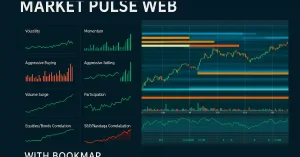In the digital age, understanding website user behavior is essential for creating engaging and effective online experiences. One powerful tool that web designers and marketers use to gain these insights is the heatmap. Heatmaps visually represent how users interact with a webpage, highlighting areas of high and low activity. In this article, we’ll explore heatmaps, how they work, their types, benefits, and how to use them to improve your website’s user experience.
What Are Heatmaps?
Heatmaps are graphical representations of data where values are depicted by color. In the context of websites, heatmaps visualize user interactions, such as clicks, taps, and scrolling behavior. The areas with the most activity are usually in warm colors like red and orange, while areas with less activity are in cooler colors like blue and green.
Types of Heatmaps
There are several types of heatmaps, each offering unique insights into user behavior:
- Click Heatmaps: These heatmaps show where users click on a webpage. This can help you identify which elements are attracting attention and which are being ignored.
- Scroll Heatmaps: Scroll heatmaps indicate how far down the page users scroll. This helps you understand if users see your important content or if it’s being missed.
- Mouse Movement Heatmaps: This track where users move their mouse cursor, which often correlates with where they are looking. This can provide insights into the user’s reading patterns and areas of interest.
- Attention Heatmaps: These combine click, scroll, and mouse movement data to show which parts of the page receive the most overall attention.
Benefits of Using Heatmaps
Heatmaps offer several advantages for understanding user behavior:
- Visual Representation: Heatmaps provide an intuitive and easy-to-understand visual representation of user interactions, making it easier to identify trends and patterns.
- Identify Problem Areas: Heatmaps can help you identify elements that may be confusing or unappealing to users by highlighting areas of low engagement.
- Optimize Layout: Understanding where users click and scroll can help you optimize the layout and placement of key elements, such as call-to-action buttons and important content.
- Enhance User Experience: By making data-driven decisions based on heatmap insights, you can improve the overall user experience, leading to higher engagement and conversion rates.
- Support A/B Testing: Heatmaps can complement A/B testing by providing visual feedback on how changes to a webpage impact user behavior.
How to Implement Heatmaps
Implementing heatmaps on your website involves a few key steps:
- Choose a Heatmap Tool: There are several heatmap tools available, such as Hotjar, Crazy Egg, and Google Analytics. Choose one that fits your needs and budget.
- Install the Tool: Most heatmap tools require adding JavaScript code to your website. Follow the instructions provided by the tool to set it up.
- Define Your Goals: Before analyzing heatmaps, define what you want to learn. Are you trying to understand why users are not clicking on a specific button? Or do you want to see how far down the page users scroll?
- Collect Data: Allow the heatmap tool to collect data for a sufficient period, typically a few days to a few weeks, depending on your website’s traffic.
- Analyze the Data: Review the heatmap visualizations to identify trends and areas for improvement. Look for patterns in user behavior that align with or contradict your expectations.
- Make Changes: Based on your analysis, make data-driven changes to your website. This could involve redesigning certain elements, changing content placement, or simplifying navigation.
- Test and Iterate: After making changes, continue to monitor user behavior with heatmaps to see if the changes had the desired effect. Be prepared to iterate and make further adjustments as needed.
Case Study: Improving User Engagement with Heatmaps
To illustrate the power of heatmaps, let’s look at a case study involving an e-commerce website.
Background: An online clothing retailer noticed that their product pages had a high bounce rate. Users were visiting the pages but leaving without making a purchase.
Goal: The goal was to understand why users were not engaging with the product pages and to increase the conversion rate.
Implementation: The retailer used Hotjar to implement click and scroll heatmaps on their product pages.
Analysis:
- Click Heatmap: The click heatmap revealed that users were primarily clicking on the product images and the “Add to Cart” button. However, there were very few clicks on the product descriptions and size guide links.
- Scroll Heatmap: The scroll heatmap showed that most users did not scroll past the product images, meaning they were missing important information like product details and customer reviews located further down the page.
Changes Made:
- Redesign Layout: The retailer redesigned the product pages to place product descriptions and size guides closer to the top, alongside the images.
- Highlight Reviews: Customer reviews were moved up the page and visually highlighted to draw more attention.
- Improve Navigation: They added quick links to jump to different sections of the page, making it easier for users to find the information they needed.
Results: After implementing these changes, the retailer saw a significant increase in user engagement on the product pages. The bounce rate decreased by 20%, and the conversion rate increased by 15%.
This case study demonstrates how heatmaps can provide actionable insights that lead to meaningful improvements in user experience and business outcomes.
Best Practices for Using Heatmaps
To get the most out of heatmaps, follow these best practices:
- Segment Your Audience: Use heatmaps to analyze different segments of your audience separately. For example, compare new visitors with returning visitors or mobile users with desktop users.
- Combine with Other Data: Use heatmap insights in conjunction with other analytics data, such as session recordings and user feedback, to get a comprehensive understanding of user behavior.
- Focus on Key Pages: Start with the most important pages on your website, such as the homepage, landing pages, and checkout pages. These pages typically have the most impact on user experience and business goals.
- Test Hypotheses: Use heatmaps to test specific hypotheses about user behavior. For example, if you think a button is too small or hard to find, use a click heatmap to confirm or refute this hypothesis.
- Iterate Regularly: User behavior can change over time, especially if you make significant changes to your website. Regularly review heatmap data to ensure your site continues to meet user needs.
Challenges and Limitations of Heatmaps
While heatmaps are a powerful tool, they do have limitations:
- Qualitative Data: Heatmaps provide qualitative data, showing where users click or scroll, but not why they behave that way. Combine heatmaps with qualitative methods like user interviews to gain deeper insights.
- Sample Size: Ensure you have a large enough sample size to draw meaningful conclusions. Small sample sizes can lead to misleading results.
- Context: Heatmaps show aggregated data, which can sometimes hide individual user behaviors and nuances. Use session recordings to see the context behind the heatmap data.
- Overreliance: Avoid over-reliance on heatmaps alone. They are one tool in your analytics toolkit and should be used alongside other methods to get a full picture of user behavior.
Conclusion
Heatmaps are an invaluable tool for understanding user behavior on websites. By providing a visual representation of user interactions, heatmaps help you identify areas for improvement, optimize layout and content, and enhance the overall user experience. Implementing heatmaps involves choosing the right tool, collecting and analyzing data, and making data-driven changes. When used effectively, heatmaps can lead to significant improvements in engagement and conversion rates, as demonstrated by the case study.
By following best practices and being aware of the limitations, you can leverage heatmaps to create a more user-friendly and successful website. Whether you’re a web designer, marketer, or business owner, understanding and utilizing heatmaps can give you a competitive edge in the digital landscape.
FAQs
What are heatmaps and how do they help websites?
Heatmaps visually show user interactions like clicks and scrolls with colors (red for high activity, blue for low), helping identify trends, optimize layouts, and enhance user experience, leading to better engagement and conversions on your site.
What types of heatmaps can I use to analyze user behavior?
You can use click heatmaps to see where users click, scroll heatmaps to track page depth, mouse movement heatmaps for reading patterns, and attention heatmaps combining all data to highlight overall focus areas on your webpage.
How do I implement heatmaps on my website?
Choose a tool like Hotjar, add its JavaScript code, define goals (e.g., click tracking), collect data over days, analyze patterns, make layout changes, and iterate using ongoing heatmap monitoring for continuous improvement.
What benefits do heatmaps offer for website optimization?
Heatmaps provide intuitive visuals to spot low-engagement areas, optimize key element placement, enhance user experience, support A/B testing, and boost conversion rates by revealing actionable user behavior insights.
What are the limitations of using heatmaps for analysis?
Heatmaps offer qualitative data without explaining why users act, require large samples to avoid bias, may hide individual nuances, and shouldn’t be over-relied upon—combine with recordings and interviews for deeper insights.





